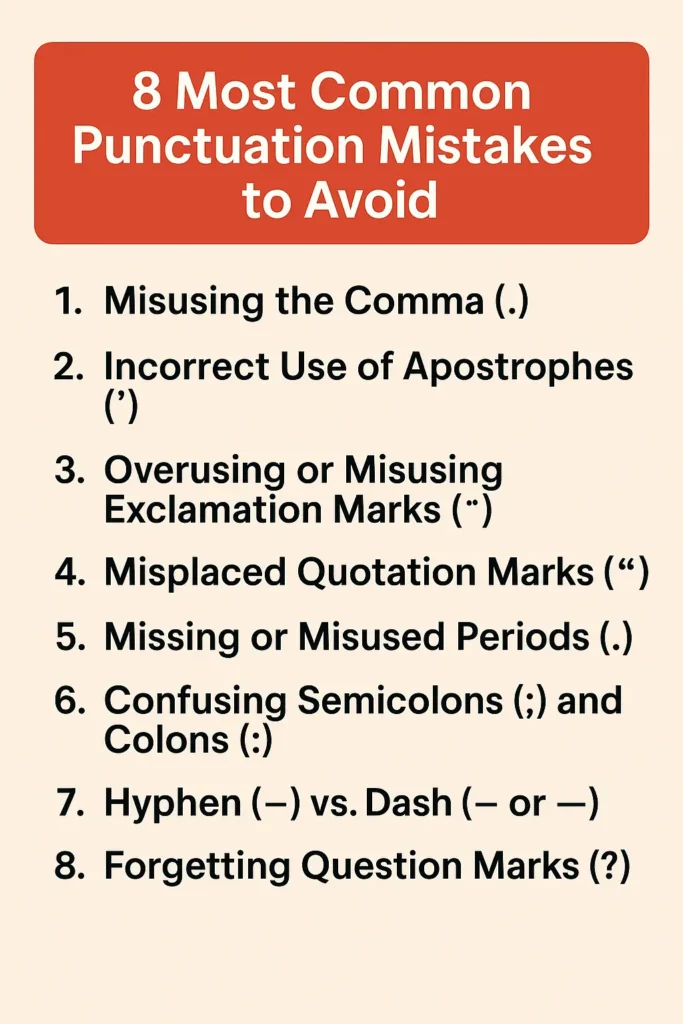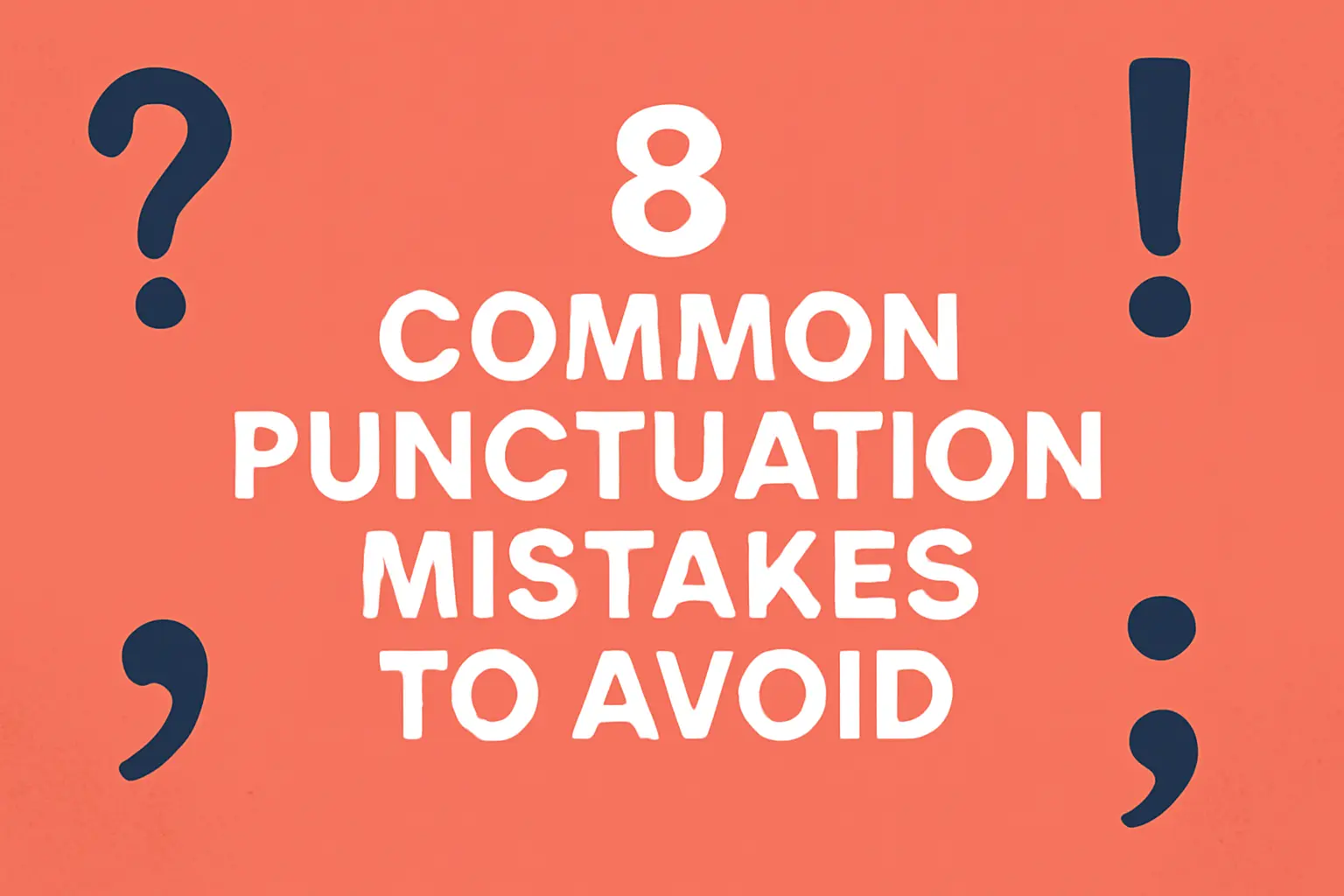Introduction: The Importance of Punctuation in Clear Communication
Punctuation plays a crucial role in clear communication. It helps break down sentences, making it easier for readers to understand the message. Without proper punctuation, even the simplest ideas can become confusing. A small punctuation error can completely change the meaning of a sentence, leading to misunderstandings. Here is the list of 8 Common Punctuation Mistakes to Avoid in this article with complete details.
For example, consider the difference between “Let’s eat, Grandma” and “Let’s eat Grandma.” The placement of a single comma changes the entire meaning. This shows how vital punctuation is in ensuring your message is delivered correctly.
You can also Check our Figurative Language Checker
By understanding and avoiding common punctuation mistakes, you can improve your writing clarity and professionalism. Whether you’re writing an email, a report, or a social media post, correct punctuation enhances the readability and effectiveness of your message. Mastering punctuation helps you communicate with precision and confidence, ensuring that your audience grasps your ideas the way you intend.

8 Common Punctuation Mistakes to Avoid
1. Misusing Commas:
Misusing commas is one of the most common punctuation mistakes. Missing commas in compound sentences or overusing them can confuse readers. For example, “Let’s eat, Grandma” vs. “Let’s eat Grandma” shows how a misplaced comma can change the meaning entirely.
To use commas correctly, remember to add them in lists (e.g., “I bought apples, oranges, and bananas”) and before conjunctions in compound sentences (e.g., “I wanted pizza, but we had pasta”). Commas also go after introductory phrases (e.g., “After the meeting, we went for coffee”). Proper comma use helps improve clarity and makes your writing more professional and readable.
2. Confusing Apostrophes:
Confusing apostrophes is a frequent issue in writing, especially when it comes to possessives and contractions. The key mistake is mixing up “its” and “it’s.” “Its” shows possession, as in “The dog wagged its tail,” while “it’s” is a contraction of “it is” or “it has,” as in “It’s a beautiful day.”
To avoid confusion, remember that apostrophes are used for contractions (e.g., “it’s”) but not for possessive pronouns (e.g., “its”). By correctly using apostrophes, you can ensure your writing is clear, precise, and professional. Understanding these rules helps improve writing accuracy and readability.
3. Overusing Exclamation Marks: A Common Writing Mistake
Overusing exclamation marks is a common punctuation mistake that can weaken writing and make it seem exaggerated or unprofessional. When used too often, exclamation marks lose their impact, making the writing appear overly dramatic. For example, “Wow!!” vs. “Wow” — the second sentence feels more refined and impactful.
To maintain a professional tone, use exclamation marks sparingly. They should only be used to emphasize true excitement or strong emotion. By limiting their use, your writing will appear more polished and controlled, ensuring your message is clear without sounding overly enthusiastic.
4. Incorrect Use of Quotation Marks:
Incorrect use of quotation marks is a common punctuation mistake that can confuse readers. One frequent error is the wrong placement of punctuation marks like commas and periods. For instance, “Hello,” she said. is correct, while “Hello”. she said. is not.
In American English, punctuation marks such as commas and periods should always go inside the quotation marks. This simple rule helps maintain clarity and ensures that your writing adheres to standard punctuation conventions. By using quotation marks correctly, you enhance the readability and professionalism of your writing, making your message clear to your audience.
5. Misplacing Colons and Semicolons:
Misplacing colons and semicolons is a common punctuation mistake that can confuse readers. While both marks are used to separate parts of a sentence, they have different purposes. A colon is used to introduce a list, explanation, or quote, such as in “I have three pets: a dog, a cat, and a rabbit.” On the other hand, a semicolon connects closely related independent clauses, like in “I have three pets; a dog, a cat, and a rabbit.”
To avoid confusion, remember: use a colon before lists or explanations and a semicolon to link two independent clauses. Mastering these simple rules ensures your writing flows clearly and professionally.
6. The Run-On Sentence and Missing Periods:
Run-on sentences and missing periods are common writing mistakes that can make your work unclear and hard to follow. A run-on sentence happens when two or more independent clauses are incorrectly joined without proper punctuation. For example, “I went to the store I bought some fruit” is incorrect, while “I went to the store. I bought some fruit.” is correct.
To avoid run-on sentences, break up long sentences with periods or semicolons. Always ensure each thought has its own ending point. Using periods helps clearly separate ideas, making your writing easier to read and understand. This simple punctuation habit improves clarity and professionalism.
7. Misusing Hyphens, Dashes, and En Dashes:
Misusing hyphens, dashes, and en dashes is a common punctuation error that can confuse readers. A hyphen (-) is used to join words in compound adjectives, like “five-year plan.” A dash (—) is used to create a strong break in a sentence, such as “The meeting was postponed—again.” An en dash (–) is typically used to show a range, like “The meeting will be from 2:00–4:00.”
To avoid confusion, remember: use hyphens for compound adjectives, en dashes for ranges, and dashes for breaks in thoughts or sentences. Proper use of these marks helps improve readability and clarity in your writing.
8. Using Ellipses Incorrectly:
Ellipses are often misused to show unfinished thoughts or pauses in writing, leading to confusion. For example, “I was thinking… maybe I could help” is correct, as it shows an unfinished thought. However, “I was thinking maybe I could help” doesn’t need ellipses and sounds more straightforward.
To use ellipses properly, they should indicate omitted words in a quote or an unfinished thought, not just a pause. Avoid overusing them in regular sentences, as they can make writing feel incomplete or vague. When used correctly, ellipses help maintain clarity and add depth to your writing.
Conclusion
Mastering punctuation is essential for clear and effective communication. Proper punctuation ensures that your message is understood exactly as you intend, while small errors can lead to confusion and misunderstandings. By avoiding common mistakes like misusing commas, apostrophes, and dashes, you can make your writing more professional and easy to read.
Final Tips: Always proofread your work carefully and check for punctuation errors. A quick review can make a huge difference in how your writing is received.
Engagement: We’d love to hear from you! Share any punctuation mistakes you’ve made or tips you use to improve your writing in the comments below. Let’s learn together!

